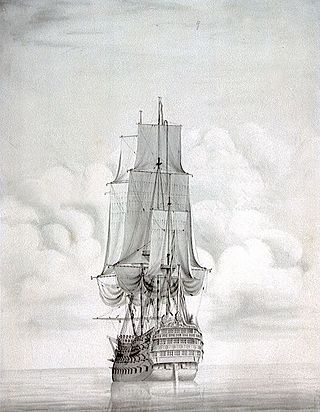
HMS Vanguard was a 90-gun second-rate ship of the line of the Royal Navy, built at Portsmouth Dockyard and launched in 1678.
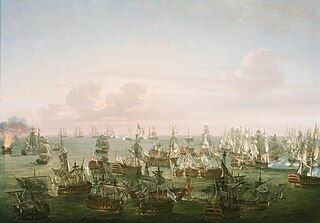
HMS Mars was a 74-gun third-rate ship of the line of the Royal Navy, launched on 25 October 1794 at Deptford Dockyard.

HMS Royal Oak was a 74-gun third-rate ship of the line of the Royal Navy, built by Jonas Shish at Deptford and launched in 1674. She was one of only three Royal Navy ships to be equipped with the Rupertinoe naval gun. Life aboard her when cruising in the Mediterranean Sea in 1679 is described in the diary of Henry Teonge.
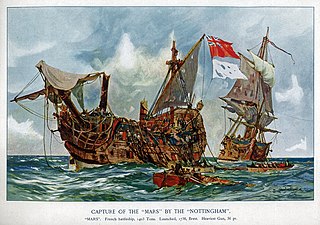
HMS Nottingham was a 60-gun fourth-rate ship of the line of the Royal Navy, built at Deptford Dockyard and launched on 10 June 1703. She was the first ship to bear the name.

HMS Culloden was a 74-gun third-rate ship of the line of the Royal Navy, built according to the dimensions laid out by the 1741 proposals of the 1719 Establishment at Deptford Dockyard, and launched on 9 September 1747. She was the first ship to bear the name, and was named for the Battle of Culloden, which had been fought the previous year.

HMS Northumberland was a 70-gun third-rate ship of the line of the Royal Navy, built at Deptford Dockyard and launched in 1705.
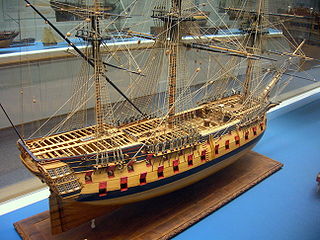
HMS Hercules was a 74-gun third-rate ship of the line of the Royal Navy, designed by Sir Thomas Slade and built at Deptford Dockyard by Adam Hayes and launched on 15 March 1759.

The Dublin-class ships of the line were a class of seven 74-gun third rates, designed for the Royal Navy by Sir Thomas Slade.
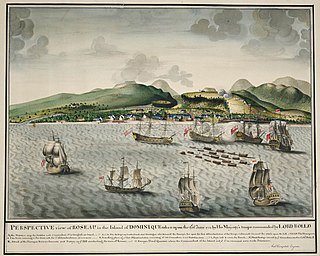
HMS Dublin was a 74-gun third rate ship of the line of the Royal Navy, built by Adam Hayes at Deptford Dockyard and launched on 6 May 1757.

HMS Valiant was a 70-gun third rate ship of the line of the Royal Navy, modelled on the captured French ship Invincible and launched on 1 August 1759 at Chatham Dockyard. Her construction, launch and fitting-out are the theme of the 'Wooden Walls' visitor experience at Chatham Historic Dockyard. She served under Augustus Keppel during the Seven Years' War, and was with him at the Capture of Havana, in 1763.

The Valiant-class ships of the line were a class of two 74-gun third rates of the Royal Navy.

The Mars-class ships of the line were a class of two 74-gun third rates of the large class ships of the line, designed for the Royal Navy by Sir John Henslow.

HMS Prince of Orange was a 70-gun third rate ship of the line of the Royal Navy, built by Richard Stacey to the 1719 Establishment at Deptford Dockyard, and launched on 5 September 1734.

HMS Deptford was a 60-gun fourth rate ship of the line of the Royal Navy, built to the dimensions of the 1719 Establishment at Deptford Dockyard, and launched on 22 August 1732.

HMS Berwick was a 70-gun third-rate ship of the line of the Royal Navy, built by Joseph Allin the younger to the 1733 proposals of the 1719 Establishment at Deptford Dockyard, and launched on 13 June 1743. It participated in the Battle of Toulon on 22–23 February 1744 under the command of Sir Edward Hawke.

HMS Augusta was a 60-gun fourth-rate ship of the line of the Royal Navy, built to the 1733 proposals of the 1719 Establishment at Deptford Dockyard, and launched on 1 July 1736.
HMS Severn was a 50-gun fourth rate ship of the line of the Royal Navy, built at King's Yard in Harwich by John Barnard as a sister ship to HMS Lichfield (1746) to the draught specified by the 1745 Establishment, and launched on 10 July 1747.

HMS Montagu was a 60-gun fourth rate ship of the line of the Royal Navy, designed by Edward Allin and built at Sheerness Dockyard to the standard draught for 60-gun ships as specified by the 1745 Establishment, amended in 1750, and launched on 15 September 1757.

HMS Pembroke was a 60-gun fourth rate ship of the line of the Royal Navy, designed by Sir Joseph Allin and built by Thomas Bucknall at Plymouth Dockyard to the draught specified in the 1745 Establishment as amended in 1752, and launched on 2 June 1757.

HMS Rippon was a 60-gun fourth rate ship of the line of the Royal Navy, designed by Sir Joseph Allin and built by Israel Pownoll at Woolwich Dockyard to the draught specified by the 1745 Establishment as amended in 1752, and launched on 20 January 1758.


















